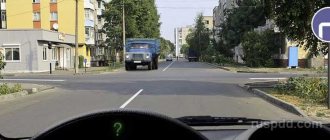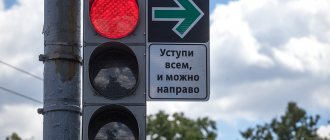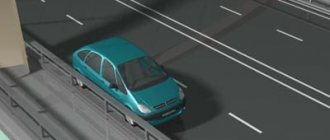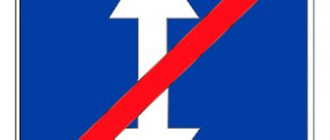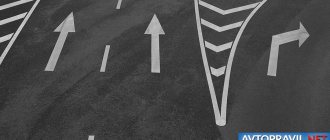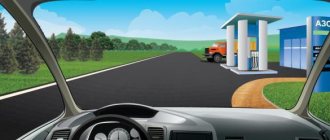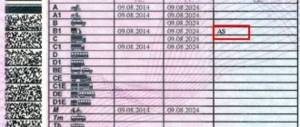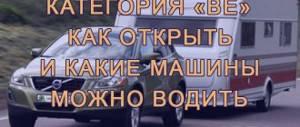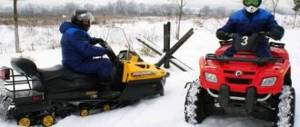Actions of drivers and pedestrians in response to a yellow traffic light
6.14.
Drivers who receive a yellow traffic light (or the equivalent of a traffic controller raising their hand) must stop. But if the vehicle is moving quickly, and stopping is impossible without emergency braking, then you don’t have to stop in the places specified in clause 6.13 of the traffic rules. Pedestrians caught on the roadway by the signal must vacate it. If it is impossible to do this, they need to stop on the line dividing multidirectional traffic flows.
If the green traffic light changes to yellow, and the vehicle is moving at a high speed, which does not allow stopping in the right place without emergency braking, the driver is given the right, in accordance with clause 6.14, to continue driving. This rule encourages some drivers to run a yellow light even if they can stop without braking.
This behavior carries a potential danger, since it happens that in the direction being crossed at this time another driver starts moving, without waiting for the yellow signal of his traffic light to change to green. The result of such a situation is an accident in which drivers get into, saving time at the expense of safety.
Pedestrians can find themselves in a difficult situation when changing permitting signals to prohibiting ones much more often. Especially those of them who are not able to quickly cross the road or return back. The only acceptable safe option for them is to stop on the line dividing multidirectional traffic flows.
Basic rules for moving in reverse flow
Which of the drivers making a turn will violate the rules?
Typically, reversing traffic is installed on straight sections of the road and on highways with a minimum number of intersections. However, in big cities problems often arise, especially if you are approaching from an adjacent street or area.
In this case, you must adhere to the following rules:
- You cannot cross the entire roadway if you need to go, for example, to the left.
- It is necessary to join the general flow and drive to the nearest intersection, at the same time changing lanes into the far left lane in order to make a U-turn at the intersection, if it is not prohibited by the rules.
- According to traffic regulations, you can enter the reverse road from any direction, and exit in the far right lane.
- Advancement is allowed only in cases where the road situation allows it.
- It is prohibited to cross marking 1.9, separating traffic flows in different directions, on the left side; this will be classified as entering oncoming traffic.
The Code of Administrative Offenses does not have special articles devoted to sections with reverse traffic, so violations will be fined based on the situation.
The most common situation is ignoring traffic lights. So, if a red cross is on, then entering the lane is equivalent to entering oncoming traffic. For this, according to Article 12.15 Part 4, a fine of 5 thousand rubles is imposed. If you commit this violation again and this fact is recorded by a traffic police inspector, you can lose your license for a year.
If there is an obstacle in front of you on the road and you go around it on the left, entering the oncoming lane, that is, crossing marking 1.9, then such a violation is considered under Article 12.15 of the Administrative Code, Part 3 - a fine of 1-1.5 thousand rubles.
The violator may also be punished for incorrectly positioning the vehicle when crossing intersections in different directions. There are certain features here. So, even if you need to turn left from the reverse lane onto a road with normal traffic, then according to the traffic rules, this can be done in such a way that your car on an ordinary road with two-way traffic takes the extreme right position.
This moment is very often recorded, because video recording cameras are posted at such intersections. In case of violation, the fine is levied under Article 12.15 Part 1 - 1,500 rubles.
To avoid all these fines, you need to follow traffic lights, markings and road signs. True, it can be encouraging that if a violation is recorded on camera, the license is not confiscated, but a fine is issued.
Despite the fact that in Europe and America this method of regulating traffic has proven itself to be the best and has been actively used since the late nineties, in Russia they reacted ambiguously to this. When the reverse movement was first used in our country, its opponents appeared. Indeed, as practice has shown, this had no effect on reducing the number of accidents; on the contrary, when organizing it, some drivers began to get confused and make mistakes.
Thus, scientists from European countries conducted experiments, which as a result showed that adjusting the reversibility has no effect on reducing accidents. Of course, the positive aspects include the fact that this makes it possible to achieve an increase in the average speed of about 10 km/h, and in some cases more. This method allows you to increase capacity, both on temporary sections of roads during their repairs, and during peak hours.
This movement is rarely used in Russia and only in large cities. Examples include a small number of streets in Moscow, Samara, and the city of Yekaterinburg, where Sheinkman Street temporarily becomes one-way during morning rush hours.
Sanctions
Incorrect behavior on a reverse road is punishable by fines and sometimes leads to deprivation of your license.
The main types of offenses and sanctions for them include:
- Not changing lanes at the end of the reverse lane - five hundred rubles.
- Ignoring traffic lights when entering a lane - one thousand rubles.
- Entering the lane when the traffic light is off during the first incident - five thousand rubles, the next time - deprivation of your driver's license for one year.
If the device is disabled or faulty, then the broken lines of the reverse road become solid, that is, driving on them is punishable as driving in the oncoming lane.
Thus, the main thing when driving in reverse is the traffic light, and the markings and signs simply indicate the principle of movement when the device is turned on.
Driving into the oncoming lane is one of the most serious violations of traffic rules; therefore, if you are not sure of the operating condition of the device, we recommend not changing lanes.
The reversible road is used to reduce traffic congestion during busy periods. It is important to know not only the rules of driving on such a section, but also to correctly interpret traffic lights, markings and road signs. For incorrect driving, monetary fines are imposed, and in case of repeated violation - deprivation of a driver's license.
Consequences of breaking the rules
Traffic lights and light indicators
Every driver knows that when driving a vehicle on the road, it is necessary to comply with the traffic rules established by the legislation of the Russian Federation, which are designed to establish order and discipline on the highway in order to prevent road accidents and make driving as safe and convenient as possible.
So, the basic rules for driving in the reversible lane include following the traffic lights. However, drivers often violate traffic rules without even knowing it. In some cases, the driver’s inattention leads to negative consequences not only for him, but also for other motorists.
For example, during a yellow traffic light, you have the opportunity to change lanes, but only in the direction in which the arrow points. Otherwise, you may receive a fine for creating an emergency on the road. Pay close attention to the traffic lights and maneuver within the limits of the rules established for reversing traffic.
Another most common violation is changing the traffic lane from reverse to normal. Fines are one of the unpleasant consequences that can overtake a motorist for mistakes made while driving. It should be borne in mind that when crossing roads with reversible traffic, the same rules apply as when driving through regular intersections. However, when changing from a reversible lane to a regular one, the car must be located in the far right lane, where the reversible lane ends (on the right). This arrangement is required no matter which direction you plan to turn.
Remember that crossing the reversible lane markings is only possible if it is on the right side of your vehicle. This rule is especially relevant for situations when it is necessary to change a car from a lane with normal traffic to the reverse lane.
The size of the administrative fine for violating traffic rules when operating a reverse traffic light is not very severe, but is noticeable for any motorist: it can range from 500 rubles to 5,000 rubles. However, this is not the main thing. The main point when violating traffic rules is the risk of adverse consequences in the form of harm to human health, as well as deprivation of his life. By violating the traffic rules established within the operation of a reverse traffic light, you endanger not only your health and life, but also the highest values and benefits of other road users. The reversible traffic light was created with the aim of improving the quality of traffic on the roads, instilling tolerance and respect among motorists, but today in Russia these goals have not yet been achieved.
Punishment for violation of reverse movement
Reversing is an important component that every driver should learn.
There are a number of penalties for those who violate these rules:
- If the driver violated the lane rules, that is, did not take a position in the far right lane in a timely manner, then he will have to pay a fine of 500 rubles;
- A larger fine, namely 5,000 rubles, will be imposed on the person who drove into the reverse lane when the traffic light was off;
- For incorrect exit from the reverse lane, you face a fine of 1,000 rubles.
All of the above penalties will be imposed on the driver who violated the traffic rules regarding reversible lanes for the first time. If a person violates this law again, his driver’s license will be confiscated for one year.
It is also worth noting that it will be quite difficult to restore in the future. To do this you will need to pass a theoretical exam. The violator will be identified by traffic police inspectors or recorded by CCTV cameras.
The introduction of reverse traffic is necessary only on those sections of the road where there is a massive accumulation of cars or long-term repair work is being carried out. Such regulation is used in practice in several progressive countries, for example, in the USA, North America or Australia.
Unfortunately, in Russia such a rule is not yet very widespread and has a huge number of various shortcomings. However, such improvements on the roads have significantly reduced the risk of possible accidents.
Every person who sits behind the driver’s seat must understand that compliance with traffic rules is very important to save their own and others’ lives, as well as to prevent damage to the vehicle.
Didn't find the answer to your question? Find out how to solve exactly your problem - call right now: +7 (Moscow) +7 (812) 309-53-42 (St. Petersburg) It's fast and free!
Free online consultation with a car lawyer
Didn't find the answer to your question? Find out how to solve exactly your problem - call right now: +7 (Moscow) +7 (812) 309-53-42 (St. Petersburg) It's fast and free!
Consequences of breaking the rules
Crossroads and traffic lights with additional section
Every driver knows that when driving a vehicle on the road, it is necessary to comply with the traffic rules established by the legislation of the Russian Federation, which are designed to establish order and discipline on the highway in order to prevent road accidents and make driving as safe and convenient as possible.
So, the basic rules for driving in the reversible lane include following the traffic lights. However, drivers often violate traffic rules without even knowing it. In some cases, the driver’s inattention leads to negative consequences not only for him, but also for other motorists.
For example, during a yellow traffic light, you have the opportunity to change lanes, but only in the direction in which the arrow points. Otherwise, you may receive a fine for creating an emergency on the road. Pay close attention to the traffic lights and maneuver within the limits of the rules established for reversing traffic.
Another most common violation is changing the traffic lane from reverse to normal. Fines are one of the unpleasant consequences that can overtake a motorist for mistakes made while driving. It should be borne in mind that when crossing roads with reversible traffic, the same rules apply as when driving through regular intersections. However, when changing from a reversible lane to a regular one, the car must be located in the far right lane, where the reversible lane ends (on the right). This arrangement is required no matter which direction you plan to turn.
The size of the administrative fine for violating traffic rules when operating a reverse traffic light is not very severe, but is noticeable for any motorist: it can range from 500 rubles to 5,000 rubles. However, this is not the main thing. The main point when violating traffic rules is the risk of adverse consequences in the form of harm to human health, as well as deprivation of his life. By violating the traffic rules established within the operation of a reverse traffic light, you endanger not only your health and life, but also the highest values and benefits of other road users. The reversible traffic light was created with the aim of improving the quality of traffic on the roads, instilling tolerance and respect among motorists, but today in Russia these goals have not yet been achieved.
Reversible traffic light - what is it?
Reversing traffic on the road
Another interesting thing about the yellow signal is that the arrow can point in any direction . And if changing to the right lane from the middle lane is a fairly understandable phenomenon, then changing from the middle lane to the left is a rather interesting phenomenon. I don’t know what such a traffic light could be used for. I note that it also does not oblige you to move in the direction of the arrow, but only informs about it. Therefore, if you are asked to change lanes to the left, then you can, without violating the rules, change to the right lane, traffic in which is not prohibited.
The main signals of a reversible traffic light can be supplemented by a yellow signal in the form of an arrow, tilted diagonally down to the right or left, the inclusion of which informs about the upcoming change of signal and the need to change lanes to which the arrow points.
To regulate the movement of vehicles along lanes of the roadway, in particular along those in which the direction of movement can change to the opposite, reversible traffic lights with a red X-shaped signal and a green signal in the form of an arrow pointing downwards are used. These signals respectively prohibit or allow movement in the lane above which they are located.
The signals of the simplest reversible traffic light are similar to the signals of a regular round traffic light, with the only difference being that they extend their effect only to the lane above which the traffic light is installed, and not to the intersection.
Accordingly, the red cross prohibits movement in the lane, and the green arrow allows it.
Types of traffic lights
The Russian Traffic Regulations describe several types of semaphores, described below.
For street transport
Such devices generally consist of three signals of different colors. Each of these colors has its own meaning:
- A red light prohibits movement in the indicated direction. The same property is possessed by a red flashing signal and two lamps with a red light lit at the same time.
- The yellow light informs traffic participants about the upcoming change in semaphore signals. In general, this color instructs drivers to stop, but in the following situations, driving when the light is yellow is permitted: The car is already at the intersection when the yellow light is on;
- The car cannot stop, thereby fulfilling the requirement of the control device, without the driver using methods of emergency stopping the car.
A flashing yellow lamp allows vehicles to pass through the intersection, informing drivers that they are on an unregulated section of the road or a pedestrian crossing. This signal can be considered as a warning to drivers about the danger that may arise on this section of the road.
A green light allows vehicle movement in the indicated direction.
Two-section
These units are used in the following cases:
- To regulate the flow of transport moving through the internal territory of enterprises;
- To organize driving on an open lane during road works or temporary narrowing of the road.
Semaphores, consisting of two sections, can also be used to regulate passage through railway crossings. In this case, two alternately flashing red signals prohibit vehicles from passing the crossing.
Along with two-section devices, control devices with one lamp are used to control the passage of vehicles at railway crossings. In this case, a red LED light obliges drivers to stop before crossing, while a white LED light allows drivers to pass the crossing.
Single section with yellow light
A few words should be said about the single-section unit.
A similar device is sometimes installed in front of intersections that do not have means of traffic control.
With additional sections and arrows
Semaphores equipped with sections with arrows are often found on roads. These sections regulate movement in the direction of the arrow shown on them. The color values remain the same as in the case of devices for street transport.
In some cases, arrows are used in transport semaphores that do not have sections. As a rule, such devices are designed to regulate traffic in specific lanes.
Reversible
Similar devices are used when organizing reverse traffic along one of the lanes. The colors of the lanterns in this case have the following meaning:
- A red light in the shape of the letter X prohibits the movement of vehicles in this lane;
- The green arrow allows movement along the lane;
- The yellow arrow indicates a prohibition on movement in the lane immediately after the traffic light, and also indicates the direction of exit from the lane.
To regulate the movement of trams
Such traffic lights have four moon-white lights placed in the shape of the letter “T”. All meanings of these devices are listed below:
- If all semaphore sections are lit, the tram can move in any direction;
- If only the lower and upper central lights are on, then only straight driving is allowed;
- When the lower and extreme left or right sections of the device are on, it is allowed to turn left or right, respectively. If both outer sections are lit, then turning is allowed in both directions;
- If, when performing the previous device, the white-lunar lamp in the center of the semaphore lights up, then the tram can also continue moving straight;
- Finally, the top three lights of the traffic light signal the trams to stop.
Pedestrian and bicycle crossings
Devices designed to control pedestrian crossings usually consist of two red and green lamps, indicating the prohibition and permission of movement along the crossing, respectively.
Often the lamps of such devices have the appearance of a schematically depicted person.
Bicycle semaphores can have three lamps: red, yellow and green. These lamps can also be shaped like a schematic bicycle. Sometimes, when installing such devices, a sign is also installed indicating that the effect of this semaphore applies only to cyclists.
Methods for organizing reverse movement
Practice has made it possible to develop a number of proven techniques on how to organize reverse traffic on highways. One of the most common options is the installation of special signs signaling that drivers are about to enter a road with reverse traffic ahead. In addition, special road markings and special traffic lights are used for informational purposes.
Road markings
It is worth emphasizing the important point that the distinctive feature of reverses is their temporary nature. Because of this, road markings are not used very often in such cases. There is a logical explanation for this. So, first, carefully apply it to the road surface, and then thoroughly eliminate the troublesome task, which requires considerable expenditure of resources, including materials and time. However, it is also practiced.
Reverse roads are indicated by a double broken line. The gap in such a line is 3 times shorter than in its main part. There are no separate road signs to indicate reversing on the lanes. This creates a lot of difficulties for drivers, especially those without much experience, if, say, the track is snowy or covered with mud, or the reverse markers have worn out over time and are not visible from the cockpit.
Traffic lights
To facilitate the movement of cars on reversible lanes, special traffic lights are often used:
- they give green signs in the form of arrows, the points of which are aimed downward;
- traffic lights are used, equipped with the ability to display red X-shaped signals, and the commands of such traffic lights are valid only on those lanes over which they are posted;
- Signaling is also practiced using yellow signs in the form of arrows aimed diagonally downwards, to the right or left. If reversing traffic lights are yellow, this is a signal that drivers should immediately begin changing lanes to enter the adjacent lane.
When the traffic lights above the reversible lanes do not work or the signals are red, you are not allowed to enter it.
Special characters
On domestic highways, special signs are used, the purpose of which is to promptly signal motorists about reverse torques. Often a sign with a white vertical arrow outline is used. It has two tips and is depicted against a blue background. This symbol indicates the beginning of the reversible path. If such an arrow is crossed out with a red stripe, this is a warning that the reverse stripe is completed. The meaning of a white arrow with tips in different directions is to warn that a reverse is ahead, but it is installed most often at intersections.
Reverse traffic sign
In conclusion, it should be recalled that if a driver violates the rules of reversing traffic, he faces various penalties. The size of the fines depends, naturally, on the nature of the violation and can in some cases reach 5 thousand rubles, and if the person who committed it repeats the violation, the driver can be deprived of his driver’s license for up to one year. Be as vigilant as possible while driving, and may driving luck always accompany you!
Nuances of reverse movement
An interesting fact about a yellow reverse traffic light: the tip of the arrow can point to any adjacent side. Changing over to the right lane is, in principle, quite simple. But going to the left is an interesting maneuver.
After all, the direction of the arrow does not oblige you to change lanes strictly to the indicated side, but only informs. Based on this, when asked to turn left, you can move into the right lane, which is also permitted, without violating traffic rules.
Drivers are often punished for making the wrong exit from a reverse road onto a regular one. In order not to shell out your hard-earned money for a fine, you need to remember one of the points of the traffic rules. Your vehicle should be positioned in the far right lane, at an intersection where the reversible lane ends on the right.
Even if you plan to turn left later.
Crossing roads with reverse traffic is carried out taking into account the same rules as driving through regular intersections. You should always remember this, and moving around will not be difficult.
Stopping on a road with reverse traffic is strictly prohibited.
It is allowed to cross the markings only if its location is on the right side relative to you.
What is more important: a sign, a traffic light or a marking?
Traffic regulations of the Russian Federation establish the following priority of means regulating traffic:
The most important and mandatory signal is the signal given by the traffic controller; The next most important is the traffic signal; Less important are the requirements prescribed by road signs installed in a given location; Finally, the least priority are the requirements established by the markings of this part of the road.
Thus, road users are obliged to comply with the requirements indicated by the traffic light, regardless of the road signs installed in this place and the markings of this part of the road.
Every driver encounters such a device as a traffic light every day. Compliance with the requirements of traffic regulations regarding the passage of intersections with control devices installed on them makes it possible to avoid many emergency and dangerous situations, as well as to manage the flow of vehicles passing through the intersection as efficiently as possible.
Reversible traffic light signs
As already mentioned above, a reversible traffic light is presented in the form of signs that permit and prohibit movement in the reversible lane.
A traffic light signal shaped like the letter “X” in red prohibits driving in the reverse lane, since at this time cars are moving in the opposite direction. When such a signal is operating, any movement on the roadway is prohibited, including entering a regular lane. Since if this rule is violated, there is a threat of creating an emergency situation and, as a result, blocking a certain section of the road.
There is also a sign depicted as an arrow directed diagonally to the right or left corner of the square. If such a sign works, this means that the driver has the right to change lanes from one road lane to another, and in the exact direction in which the arrow points. Typically, such a sign also indicates a change from a prohibiting signal to a permissive one and vice versa, soon. It should be borne in mind that, unlike a regular traffic light, a yellow signal does not prohibit movement, but gives the opportunity to change lanes until another traffic light turns on. At the same time, changing lanes is your right, not your obligation. That is, it is not prohibited to continue driving in the reverse lane after the traffic light changes to green.
Permitting movement on the reverse lane is a signal represented as a green arrow pointing upward. When such a signal is working, you can move along the reverse lane without fear, but you should remember that the reverse traffic light only regulates traffic in the reverse lane and does not extend its effect to the rest of the road space. While such a signal is operating, it is also prohibited to change the car into another lane.
Traffic regulations on reverse traffic lights
A reversible traffic light is installed above the lane and gives only one light signal at a time. Depending on the number of lanes, a traffic light has one, two or more segments.
The signals are interpreted as follows:
- A green arrow, the tip of which is lowered, means driving in the lane is permitted.
- Red cross – cars are currently moving along the lane in the opposite direction, entry is prohibited.
- Yellow diagonal arrow pointing to the lower right corner - movement in the reverse lane ends and the driver should change lanes to the right lane.
The device is installed not only before the start of the section, but is also repeated throughout the entire road. Drivers are advised to pay close attention to the directions in order to spot the yellow arrow in a timely manner. The device may periodically turn off, in which case drivers should immediately leave the lane.
Not all reversible traffic lights are equipped with a yellow arrow function; sometimes the driver needs to navigate to the end of the row using road markings.
Why a traffic light is not always a guarantee of safety
Even when you are good at deciphering the traffic controller’s instructions or there is a properly working traffic light in front of you, it happens that traffic is still accompanied by emergency situations.
Therefore, we will give some tips:
always look in the direction of the turn, even if you are sure that only you can move at the moment; do not exceed the speed limit when driving through unfilled intersections and empty pedestrian crossings, even if you have a green light, other road users cannot always tolerate their red signal when there is an empty intersection or crossing ahead; If the traffic light is not working and there is no traffic controller, use the instructions for priority signs, but with extreme caution; many people do not even notice them.
Traffic lights for trams
The movement of route vehicles (trams, buses, etc.) moving along dedicated lanes can be controlled by traffic lights with round single-color lenses of white and moon color. People call them “traffic lights for trams.”
Such traffic lights are located in the shape of the letter “T” (the three upper signals are located horizontally, the lower one is centered relative to the upper ones) and allow traffic only when the lower signal and one/some of the upper ones are turned on simultaneously. The allowed direction of movement is determined by the location of the switched on upper signal. If the left signal is on, it means that movement to the left is allowed, if the right signal is on, it means going right, and the middle one means going straight. If all the upper signals are on and the lower one is off, then movement is prohibited.
"Tram" traffic lights
control the movement of route vehicles moving along dedicated lanes. According to clauses 13.6 and 13.11 of the Traffic Regulations, with the same rights as trackless vehicles, trams in this case have an advantage. This means that if a signal is on at a “tram” traffic light, simultaneously allowing the movement of a trackless vehicle and a tram, then the driver of the trackless vehicle must let the tram pass.
A similar rule also applies when a “tram” traffic light is adjacent to a regular three-color one. That is, the tram here also has an advantage in movement over trackless vehicles. To avoid any contradictions in the interpretation of the signals of conventional and “tram” traffic lights, all drivers, regardless of what kind of transport they drive, should know what the white-moon signals of T-shaped traffic lights mean.

